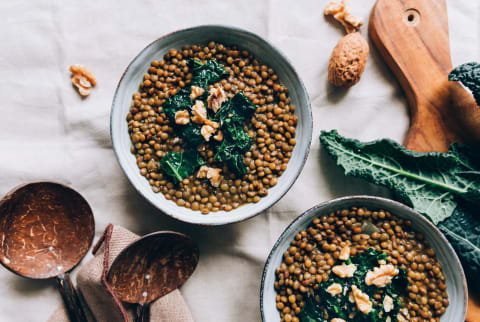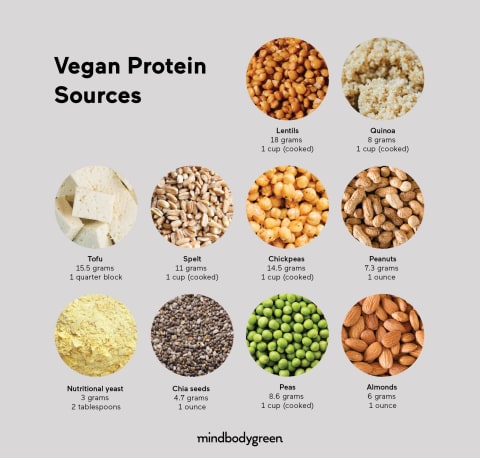
Image by Nataša Mandić / Stocksy
March 28, 2023
Whether you’re interested in cutting back a bit on animal products or becoming a full-fledged vegan, squeezing enough plant-based protein into your daily diet is crucial. However, with meat, eggs, and dairy taking center stage in so many recipes out there, figuring out how to fit more vegan protein sources into your meal plan can be tricky.
In this article, we’ll explore some of the pros and cons of vegan proteins, along with some of the top sources and signs that you may not be getting enough, according to the experts.
Advertisement
This ad is displayed using third party content and we do not control its accessibility features.
Benefits of vegan proteins
There are plenty of reasons to consider swapping animal products for plant-based proteins in your diet. Below, we take a closer look at a few of the top benefits of vegan proteins:
Advertisement
This ad is displayed using third party content and we do not control its accessibility features.
In addition to the ethical benefits of selecting vegan protein sources over animal proteins, there are some impressive perks for the planet as well.
In a review published in Advances in Nutrition, researchers reported that vegan diets1 are associated with 50% less greenhouse gas emissions than omnivore diets, not to mention significant reductions in the use of natural resources. In fact, pound-for-pound, it’s estimated that beef requires nearly 14 times more land, eight times more water, and nine times more fertilizer to produce compared to beans.
2.
They’re easy on your wallet.
Interestingly, a 2021 study in the Lancet, Planetary Health compared the costs of different diet plans, including plant-based diets. Vegan and vegetarian diets focused on whole grains and legumes rather than animal products took the top spots as the most affordable eating patterns2, even beating out other popular plans like the pescatarian diet.
Advertisement
This ad is displayed using third party content and we do not control its accessibility features.
3.
They’re often rich in other nutrients.
Many high-protein vegan foods pack quite a punch when it comes to nutrition. “Unlike animal proteins, plant-based proteins3 have fiber, vitamins, and minerals and have no saturated fat or cholesterol,” says Rhyan Geiger, RDN, a registered dietitian and chief vegan officer at Phoenix Vegan Dietitian.
According to Geiger, limiting both saturated fat and cholesterol in your diet can help keep your heart healthy and prevent cardiac events, such as heart attack or stroke. Plus, plant-based diets have been associated with a long list of other potential health benefits, ranging from better blood sugar control4 to a reduced risk of chronic conditions like cancer5 and diabetes6.
Drawbacks of vegan proteins
While there are plenty of pros for plant-based proteins, there are definitely a few drawbacks to consider as well:
Advertisement
This ad is displayed using third party content and we do not control its accessibility features.
1.
They’re lower in essential amino acids.
In general, plant-based proteins have fewer essential amino acids7, according to Mike T. Nelson, CSCS, CISSn, MSME, Ph.D., a nutrition and fitness educator specializing in human performance. “Essential amino acids are the ones that are going to trigger the repair and the building process8 and muscle, and what’s commonly called muscle protein synthesis (MPS),” says Nelson.
Vegan proteins that are low in one or more of these essential amino acids are typically deemed “incomplete proteins.” This means that many plant-based foods—including most types of nuts, seeds, and legumes—are lower in the essential amino acids (like leucine or lysine) that your body needs and generally have a lower PDCAAS score7, which is used to measure a food’s protein quality.
Nelson advises eating more vegan protein sources or combining different types of plant-based proteins with unique amino acid profiles to fill in the gaps and create a complete protein.
That being said, it’s totally possible to fit enough of these amino acids into a vegan or vegetarian diet9 unless you’re not eating enough protein or calories overall. The key is to add more diversity to your diet by enjoying a variety of vegan protein sources rather than eating the same two or three foods on repeat.
2.
They may not be absorbed as well.
Compared to animal proteins, plant-based proteins are generally not digested or absorbed as efficiently. According to a 2022 review in Journal of Agriculture and Food Research, plant proteins have absorption rates10 of about 75% to 80%, compared to around 90% to 95% for animal proteins.
The reason for this is twofold. For starters, the plant’s cell walls can interfere with the digestive process. Not only that, but certain antinutritional compounds (aka antinutrients) found in many plant foods can make it more difficult for your body to extract and absorb nutrients from the foods that you eat.
Fortunately, certain processing methods (like cooking, soaking, or fermentation) can actually boost the digestibility of vegan protein sources, so this probably isn’t a problem for most people.
Advertisement
This ad is displayed using third party content and we do not control its accessibility features.
3.
They contain less protein per serving.
Though plant-based proteins are generally leaner than animal proteins, Nelson notes that you typically have to consume a higher amount7 to meet your protein needs. This is because most vegan-friendly foods contain a lower amount of protein per serving than animal products.
Therefore, while it may be pretty easy to knock out your protein requirements with a big slab of steak or a scoop of whey protein powder on a non-vegan diet, it might take a bit more effort to fit enough protein into your diet through plant-based proteins alone.
Signs of protein deficiency
Protein deficiencies are rare, even among vegans and vegetarians. Still, learning to recognize the signs of when you might not be meeting your needs is important.
According to Geiger, if you experience any of the following symptoms, it may be a cue that it’s time to bump up your protein intake in order to better meet your daily needs:
- Weakness
- Fatigue
- Dry, flaky skin
- Brittle or thinning hair
- Deep ridges in your nails
If you’re experiencing loss of muscle mass or are frequently feeling sick, a lack of protein in your diet could also be to blame. Plus, because protein plays a key role in satiety11, it might be best to dial up your protein intake a bit if you find that you’re constantly feeling hungry between meals.
12 vegan protein sources
So, what vegan foods are high in protein? Here, we take a deep dive into 12 of the top vegan protein sources, plus a few ideas for how you can incorporate them into your daily diet.

With 18 grams of protein in each cooked cup, lentils are one of the few plant-based foods that can compete with animal products like meat when it comes to protein content. Plus, in addition to delivering a hearty dose of protein, lentils are also a great source of fiber, iron, folate, and copper.
Protein per serving: 18 grams per cooked cup12
Try it in: Smoky Chickpea, Red Lentil & Vegetable Soup
Not only does quinoa boast all nine of the essential amino acids that your body needs, but it’s also rich in fiber, manganese, and B vitamins. What’s more, it’s loaded with antioxidants13, flavonoids, and other beneficial plant compounds that can help ward off inflammation and chronic disease.
Protein per serving: 8 grams per cooked cup14
Try it in: Quinoa Breakfast Frittata
Spelt is a type of ancient grain known for its nutty flavor and impressive protein content. It also packs a good chunk of fiber, manganese, and zinc into each serving, along with essential B vitamins like niacin.
Protein per serving: 11 grams per cooked cup17
Try it in: Coconut BLT Salad
Nutritional yeast (aka nooch) is known for its ability to bring a nutty, cheesy flavor to a variety of vegan dishes. Though most recipes only call for a small amount, sprinkling a bit of nutritional yeast onto your favorite foods can be an easy, inexpensive, and tasty way to bump up your protein intake. Plus, it’s an excellent source of vitamin B1222, an important micronutrient that’s primarily found in animal products.
Protein per serving: 3 grams per 2 tablespoons23
Try it in: Healthy Roasted Garlic and Onion Dip
Cramming plenty of fiber, heart-healthy fats, and protein into each serving, these tiny seeds are true powerhouses of nutrition. Furthermore, chia seeds are also rich in antioxidants24 with potent health-promoting properties, including quercetin and kaempferol.
Protein per serving: 4.7 grams per ounce25
Try it in: Skin-Healthy Bliss Balls
Beans are a plant-based pantry staple, especially if you’re on a tight budget. Available canned, dried, or fresh, there are many types available, which each have slight variations in taste, texture, and nutritional value. Besides boosting your intake of protein26, beans can also bring extra fiber and complex carbs to your diet to help stabilize blood sugar levels.
Protein per serving: 15 grams per cooked cup of black beans27
Try it in: Black Bean Tacos
This beloved breakfast food is higher in protein than most other grains, earning it a well-deserved spot on our list. It also contains a specific type of soluble fiber known as beta-glucan, which has been studied for its ability to reduce cholesterol levels32, enhance gut health, and improve immunity.
Protein per serving: 6 grams per cooked cup33
Try it in: 10-Minute Apple Pancakes
Sample meal plan
Ready to start ramping up your protein intake? Check out the sample meal plan below for a few flavorful ideas to help get you going.
Day 1:
- Breakfast: Coconut yogurt with almonds, chia seeds, and fresh fruit
- Lunch: BBQ tofu with herbed quinoa and and roasted broccoli
- Dinner: Grain salad with spelt, chickpeas, kale, and roasted red peppers
- Snack: Homemade granola with mixed nuts, rolled oats, and dried fruit
Day 2:
- Breakfast: Oatmeal with nut butter and sliced bananas
- Lunch: Lentil curry with peas and wild rice
- Dinner: Black bean quinoa burgers with sweet potato wedges
- Snack: Roasted chickpeas with nutritional yeast
FAQ
How can a vegan get 100 grams of protein a day?
Fitting a few servings of high-protein foods into each meal can help you meet your protein goals while following a vegan diet. Geiger recommends plant-based proteins like tofu, beans, lentils, and legumes for daily consumption, which she notes can also deliver valuable nutrients like vitamin C, folic acid, and magnesium. Vegan protein powders sourced from peas, brown rice, nuts, or seeds also offer a quick and convenient way to boost your intake throughout the day.
What are some low-carb vegan protein sources?
Tofu is a great vegan protein source that’s low in carbs yet highly nutritious. Many varieties of high-protein nuts and seeds are also low in carbs, including almonds, peanuts, and chia seeds.
What are some affordable vegan protein sources?
Dried beans and lentils are great sources of protein, plus budget-friendly. Other affordable options include nutritional yeast and whole grains, such as quinoa or oats.
The takeaway
Including more vegan protein sources in your diet is a great way to save money, support your health, and minimize your environmental footprint. Though most vegan proteins are lower in certain essential amino acids and contain a lower amount of protein per serving, enjoying a variety of foods rich in protein as part of a balanced diet can help fill in the gaps. A doctor or dietitian can also provide personalized guidance on how you can modify your diet to make sure you’re meeting your protein needs.

